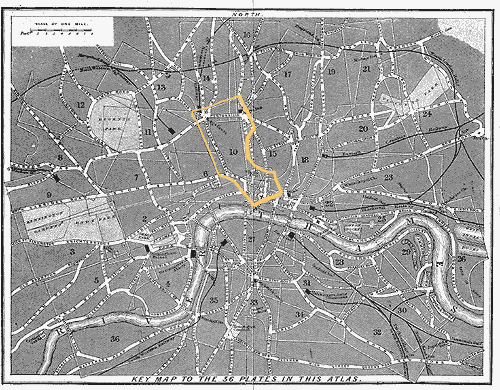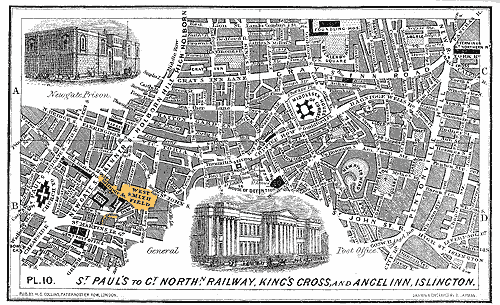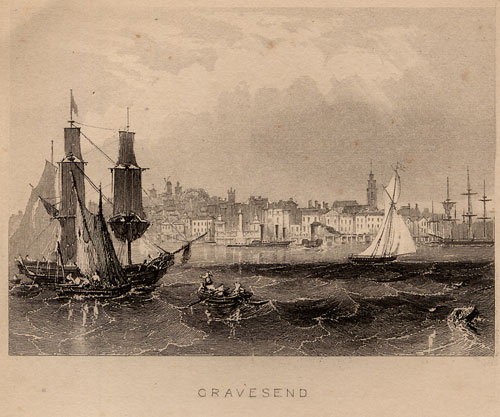|

NOTES ON THE NOVEL: ISSUE 16
Printable View
This illustration, by Marcus Stone, appeared
in the 1862 edition of Great Expectations. The original serial
(1860-1) and the 1861 editions of the novel were not illustrated.

A Note on the Maps:
William Smith's 1815 Map and Delineation of
the Strata of England and Wales with Part of Scotland gives
a detailed account of the geography and geology of most of Great
Britain. It consists of several large maps, each about 16x24 inches,
mounted on canvas. These maps can be folded into smaller squares,
and some of the seams -- where the map folds and the canvas shows
through -- are visible on the sections of the maps reproduced here.
The whole work consists of 16 large maps (a General Map of
England, Wales and Scotland, and 15 regional maps), together with
a Memoir discussing the geological study they illustrate.
Detail from Map 12, in a reduced size, is reproduced below.
The city maps used to illustrate this issue are
reproduced from Collins' Illustrated Atlas of London, published
in 1854. Pip's London would have been that of the 1820s, and Dickens'
London, at the time he was composing the novel, was that of 1860-1.
Collins' maps thus represent a London that falls between the historical
moment represented in the novel and the historical moment of the
novel's composition.
Since the chapters in this issue (Chs. 51-53)
take place in late 1829 (Meckier 160), the maps used here show a
city that has undergone about 25 years of change since Pip's time.
Nevertheless, they are very useful in tracking Pip's progress through
the city; the reader should merely keep in mind that some of the
landmarks would not have existed in the late 1820s. The most significant
of these are the railway lines marked on the Key Map -- the
railroad did not enter London until the late 1830s and early 1840s
(Tallis's Illustrated London 186-7). The Key Map also
shows a bridge that Pip would not have recognized -- the Hungerford
Bridge between Waterloo and Westminster Bridges. And London Bridge
was, in Pip's time, Old London Bridge -- a different structure,
but built in essentially the same place. (New London Bridge would
have begun construction a few yards from Old London Bridge when
Pip was living in London, but would not have replaced the old bridge
during his tenure [Meckier 162]. Given that both London Bridges
would have been mapped in the same place, the difference between
the bridges makes no difference to our reading of the map.) Any
further discrepancies will be noted where appropriate.
History and features of Collins' Atlas
(1854)
Collins' Atlas was created in response
to the amplified tourist trade in London resulting from the Great
Exhibition of 1851. Previous to the Atlas, maps tended to
be very large and unwieldy, and though large city maps could be
folded up and carried, Collins designed his maps with a specific
view to portability (Dyos 10). The Atlas consists of one
large map of the whole city of London (the Key Map), followed
by 36 plates. The Key Map is drawn with numbered sections,
and these sections are represented in detail by the plates (the
numbers on the Key Map refer to the numbers of the plates).
The chief drawback to the Atlas is that, although the Key
Map keeps North at the top, the plates do not always observe
this convention (Dyos 13). This disregard of the compass, however
puzzling to someone attempting to navigate London in 1854, is in
many respects an advantage for the modern reader: The detailed plates
-- drawn to represent popular views of the city and/or popular routes
through it -- give us a unique view of the sites of Pip's adventures
in 19th century London. Any major discrepancies between the landmarks
shown on the maps and those that Pip would have been acquainted
with (given that the map was composed in 1854, about thirty years
after Pip's tenure in London) will be indicated where appropriate.
A Note on the Illustrations
The engraved illustrations of London reproduced
in this and other issue(s) were prepared as a result of the Great
Exhibition of 1851. Tallis's Illustrated London (published
in 1851-2, in two volumes) was created specifically to commemorate
the Exhibition, and furnishes, not only a great many engravings
of London scenes, but also a long history of, and commentary on,
the sights of London and its environs. Since Tallis's Illustrated
London was published almost 25 years after the events related
in this issue (Chapters 51-53 take place in 1829 [Meckier 160]),
some of the views commemorated in Tallis's would not have
been available to Pip. Only those illustrations that show cityscapes
and landmarks as they would have appeared to Pip in the 1820s have
been included here.
A tour of chapters 51-53
The Key Map of Collins' Atlas, showing
London as a whole, gives a useful overview of the city locations
mentioned in this issue. The London locations described in Chapters
51-53 appear on the Key Map in area 10 (shown in detail on
the corresponding Plate), and eastward down the river Thames, to
Magwitch's hiding place and beyond. All of the maps reproduced here
have been highlighted for convenience of reference and increased
legibility.

At the beginning of Chapter 51, Pip and Herbert
walk together to "the corner of Giltspur Street, by Smithfield,"
where they part -- Pip destined for Jaggers' offices in Little Britain.
Giltspur Street, Smithfield, and Little Britain are visible on Plate
10 of Collins' Atlas (below). Pip and Herbert have walked
east from their lodgings in the Temple.

Note that Plate 10 of Collins' Atlas, composed
in 1854, includes certain elements of London that would not have
existed in 1829 (when Chapters 51-53 take place). The Great Northern
Railway Terminus (mentioned in the caption) was not yet constructed;
and the General Post Office (illustrated at the bottom center of
the map), though completed in 1829, would not be open for several
months (it opened in September) (Tallis's Illustrated London,
vol. 1, 206).
Pip, contemplating the escape route for Magwitch,
"always proposed to [himself] to get [Magwitch] well down the river
in the boat: certainly well beyond Gravesend" (Ch. 52). Gravesend
is a town on the river Thames almost at the Mouth of the Thames
(where the river meets the sea). Tallis's Illustrated London
offers an engraving (below) of Gravesend which, incorporating
the river, gives us a view of Pip's projected destination.

The map below shows Gravesend relative to London
and Magwitch's hiding place.
The blue box in the center of this map marks
the area covered by the Key Map of Collins' Illustrated
Atlas of London. The red box to the right of center marks the
area -- "down the Pool there between Limehouse and Greenwich" (Ch.
45) -- where Magwitch is hidden.

Land of the Arabian Nights: When Herbert
dreams of "conducting Clara Barley to the land of the Arabian Nights"
(Ch. 52), he means Egypt, for we find out later that Clarriker's
has offices in Cairo. The Arabian Nights, or The One Thousand
and One Nights is a collection of stories of diverse origin
-- Indian, Persian, and Arabic (Oxford Companion 36-7) --
connected by a frame narrative in which Scheherazade tells the king
a story every night. (The king normally kills each of his wives
the morning after the wedding-night; Scheherazade tells him stories
to sustain his interest, and to keep herself alive.)
Furlong: When Jaggers posits that a mother
and father might be living "within so many miles, furlongs, yards
if you like" (Ch. 52) of one another and not know it, he names a
measurement not now in common use. According to the Oxford English
Dictionary, a furlong was "[o]riginally, the length of the furrow
in the common field, which was theoretically regarded as a square
containing ten acres. As a lineal measure, the furlong therefore
varied according to the extent assigned at various times and places
to the acre, but was usually understood to be equal to 40 poles
(rods, perches). As early as the 9th century, it was regarded as
the equivalent of the Roman stadium, which was 1/8 of a Roman
mile; and hence furlong has always been used as a name for
the eighth part of an English mile, whether this coincided with
the agricultural measure so called or not. The present statute furlong
is 220 yards, and is equal both to the eighth part of a statute
mile, and to the side of a square of 10 statute acres."
Lime-kiln: A lime-kiln is a furnace in
which limestone is burned to create lime, which was used for various
horticultural and medical purposes. According to the Dictionary
of Daily Wants (1858-9) it furnished, in one capacity, an excellent
manure, and acted as a medical "corrosive, antacid, and depilatory"
(635) in another.
Sluice-house: A sluice-house is a building
named for, because near or associated with, a sluice. A sluice is
a mechanism for regulating the flow of water -- "A structure of
wood or masonry, a dam or embankment, for impounding the water of
a river, canal, etc., provided with an adjustable gate or gates
by which the volume of water is regulated or controlled" (OED,
"sluice"). Appropriately, the sluice-house to which Pip is
summoned is located on the marshes.
Weazen: Orlick remembers having known
Pip "when you was so small a wolf that I could have took your weazen
betwixt this finger and thumb and chucked you away dead" (Ch. 53).
"Weazen" is a corruption of "weasand," meaning, generally, the throat,
and -- more specifically -- the gullet, esophagus, etc. (OED,
"weasand"). Orlick thus refers to his ability to choke Pip to
death as a child.
Bibliographical
information
|

